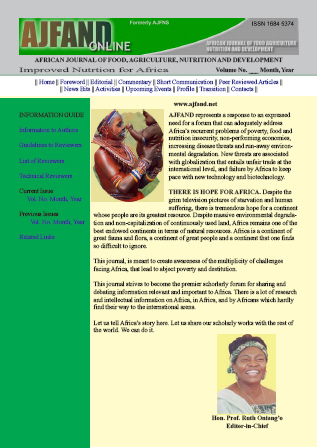
|
African Journal of Food, Agriculture, Nutrition and Development
Rural Outreach Program
ISSN: 1684-5358
EISSN: 1684-5358
Vol. 16, No. 4, 2016, pp. 11168-11184
|
 Bioline Code: nd16056
Bioline Code: nd16056
Full paper language: English
Document type: Research Article
Document available free of charge
|
|
|
African Journal of Food, Agriculture, Nutrition and Development, Vol. 16, No. 4, 2016, pp. 11168-11184
| en |
EFFECTS OF WEATHER EXTREMES ON CROP YIELDS IN NIGERIA
Ajetomobi, JO
Abstract
This study seeks to analyze how extreme weather conditions affect crop yield and risk in Nigeria and to assess the potential implications of weather extremes on the nation’s crop insurance portfolio. A panel of Nigerian state-level crop yields was paired with a fine-scale weather data set that included distribution of temperature and precipitation between the minimum and maximum across all days of the growing season for selected crops. Weather data were examined from January 1, 1991 to December 31, 2012. The analysis was started with the traditional approach of estimating climate change impact by a quadratic regression model of weather and Growing Degree Days (GDD) on crop yields using panel data estimation. Later, Harmful Degree Days (HDD) and Vapour Pressure Deficit (VPD) were step-wisely included. Interactions of rainfall, GDD and VPD were also explored. In the production approach, crop yield was specified as a function of weather inputs (temperature and precipitation). The results showed that the time when the lowest and highest yields were obtained differed by crops. The highest (43.50 kg/ha) and lowest (1.085kg/ha) yields for cassava were observed in 1999 and 2001, respectively, while both highest and lowest yields for sorghum were recorded in 2012. Daily maximum temperature between 30 and 35 °C occurred more than a 1000 times over all the days covered in this study (January 1, 1991 to December 31, 2012). The regression results showed that high damage to cassava, cotton and maize was evident by the strong and negative coefficient of Harmful Degree Days (HDD). For sorghum and rice, an exposure to heat range showed a negative influence on the yield. In order to address the negative weather effects and other problems associated with the National Agricultural Insurance Corporation (NAIC) such as little access by farmers, high information asymmetric and transaction costs, crop insurance based on indices from Nigeria Meteorological Agency (NIMET) could be adopted to compensate part of the damage caused to the farm products.
Keywords
Extreme Weather; Staple Crop; Yield Risk; Agricultural Insurance; Econometrics; Nigeria
|
| |
© Copyright 2016 - African Journal of Food, Agriculture, Nutrition and Development
Alternative site location: http://www.ajfand.net/
|
|
